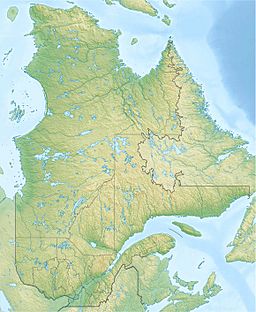Talbot Lake (Petite rivière Pikauba) facts for kids
Quick facts for kids Talbot Lake |
|
|---|---|
| Location | Lac-Pikauba |
| Coordinates | 47°51′24″N 71°15′05″W / 47.85667°N 71.25139°W |
| Lake type | Natural |
| Primary inflows | Petite rivière Pikauba, ruisseaux riverains, la décharge (venant du sud-ouest) du lac Maskwa et la décharge de plusieurs lacs dont Decoigne, Beloeil, Lanctôt, Lalonde et Dumais.. |
| Primary outflows | Petite rivière Pikauba |
| Basin countries | Canada |
| Max. length | .0 km (0 mi) |
| Max. width | 0.7 km (0.43 mi) |
| Surface elevation | 757 m (2,484 ft) |
Talbot Lake is a freshwater lake in Quebec, Canada. It is located in the unorganized territory of Lac-Pikauba. This lake is special because the Petite rivière Pikauba flows right through it! Talbot Lake is also part of the Laurentides Wildlife Reserve, a large protected area in Quebec.
The area around the lake is mostly served by Route 175, which runs along its western side. Other smaller forest roads help people get around for logging and outdoor fun. The main activities here are forestry (cutting down trees) and recreational tourism, like hiking or fishing.
Talbot Lake usually freezes over from early December to late March. It's generally safe to walk or play on the ice from mid-December to mid-March.
Contents
Exploring Talbot Lake: Its Location and Features
Talbot Lake is like a wider part of the Petite rivière Pikauba. A dam at its outflow helps control the water level. The southern and western shores of the lake are quite marshy.
This lake is about 7.0 km (4.3 mi) long and 1.3 km (0.81 mi) wide. It sits at an altitude of 757 m (2,484 ft) above sea level. The main water source for Talbot Lake is the Petite rivière Pikauba, which flows into it from the northeast. Other smaller streams and outlets from nearby lakes also feed into it.
The lake is surrounded by mountains, especially on its east and south sides. Some of these mountain peaks reach heights of over 900 m (3,000 ft).
Where Does the Water Go?
From Talbot Lake, the water travels a long way!
- First, it flows through the Petite rivière Pikauba for about 46.8 km (29.1 mi).
- Then, it joins the Pikauba River and flows for another 26.5 km (16.5 mi).
- Next, the water enters Kenogami Lake for about 17.6 km (10.9 mi).
- After that, it flows into the Chicoutimi River for 26.2 km (16.3 mi).
- Finally, the water reaches the Saguenay River and travels 114.6 km (71.2 mi) eastward to Tadoussac. There, it joins the mighty Saint Lawrence estuary, which leads to the Atlantic Ocean!
Why Is It Called Talbot Lake?
The name "Talbot" comes from a French family name. In 1949, the Quebec Geography Commission decided to name the lake "Talbot Lake." This name honors Antonio Talbot (1900-1980).
Antonio Talbot was a lawyer who worked in Quebec. He later moved to the Saguenay region. He was a representative for Chicoutimi in Quebec from 1938 to 1965. Antonio Talbot was a strong supporter of his region. As the Minister of Highways from 1944 to 1960, he helped build the important road connecting Quebec City to the Saguenay – Lac-Saint-Jean area. This road made it much easier to travel to the region, which before could only be reached through a difficult route. The road was finished in 1951, and since 1999, a part of it has been known as the Antonio-Talbot road.
The name "Lac Talbot" was officially recognized on December 5, 1968, by the Commission de toponymie du Québec.
Related Articles
- Charlevoix Regional County Municipality
- Lac-Pikauba, an unorganized territory
- Petite rivière Pikauba
- Pikauba River
- Kenogami Lake
- Chicoutimi River
- Saguenay River
- St. Lawrence River
- List of lakes in Canada


